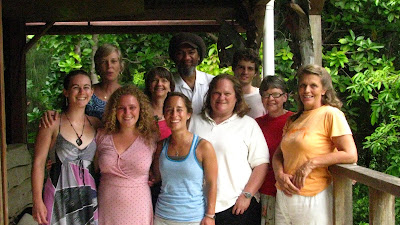 Strength. While I don’t like the conditions that keep testing them, I do like and admire the physical, emotional, and spiritual strength of the Haitians. It’s astounding how they endure things that would have made most of us crumble long ago.
Strength. While I don’t like the conditions that keep testing them, I do like and admire the physical, emotional, and spiritual strength of the Haitians. It’s astounding how they endure things that would have made most of us crumble long ago. 

Patience. I like that Haitians don’t fret traffic jams, they patiently tolerate the fumblings of foreigners trying to help, and I watched this Haitian fellow patiently and kindly help Yvonne learn some Creole for quite a long time on the patio.
Sharing. In the van one day, Carla bought us all a bunch of chips in plastic bags. When we stopped to pick up some Haitian friends of hers, she gave each of them a bag to eat too. When one man was dropped off first, he took his unopened bag with him. “See that?” Carla shared, “he’s taking that home to his family to share with them. Haitians always think of others when they receive something.”
Big is Beautiful. Upon arriving at the wharf for our ferry ride to La Gonave our van was swarmed by a dozen men wanting to carry our bags to the boat. Hot and sweaty, in NO WAY looking my best, I climbed out of the van under the stare of 12 sets of eyes. “Big woman!” one of the men said appreciatively while the others nodded. All righty then.
Artists. In Port au Prince-- a city where there isn’t much natural beauty-- public art stands out as a lily among thorns. I admired much of the graffiti, and their public buses are fancied up real purty too!

Local Heroes. All over Haiti there are people like Mona and William who have other passions and responsibilities, yet remain committed to their communities and work hard to raise the quality of life around them. I can only guess at the massive number of local heroes who share their food and water, offer their personal space for a stranger to sleep in, care for orphans who lost family members in the earthquake. Heck, I considered Madame Antoine a local hero for cooking over open fires in this “kitchen” and churning out delicious meals for us guests every day.
 Average Haitians rise up every day and make good things happen.
Average Haitians rise up every day and make good things happen. A Great Saying. In Creole—as in English—there are a large variety of responses you can give when someone asks “How are you?” My favorite response is “Map bat zel mwen” (I’m still beating my wings!)



































